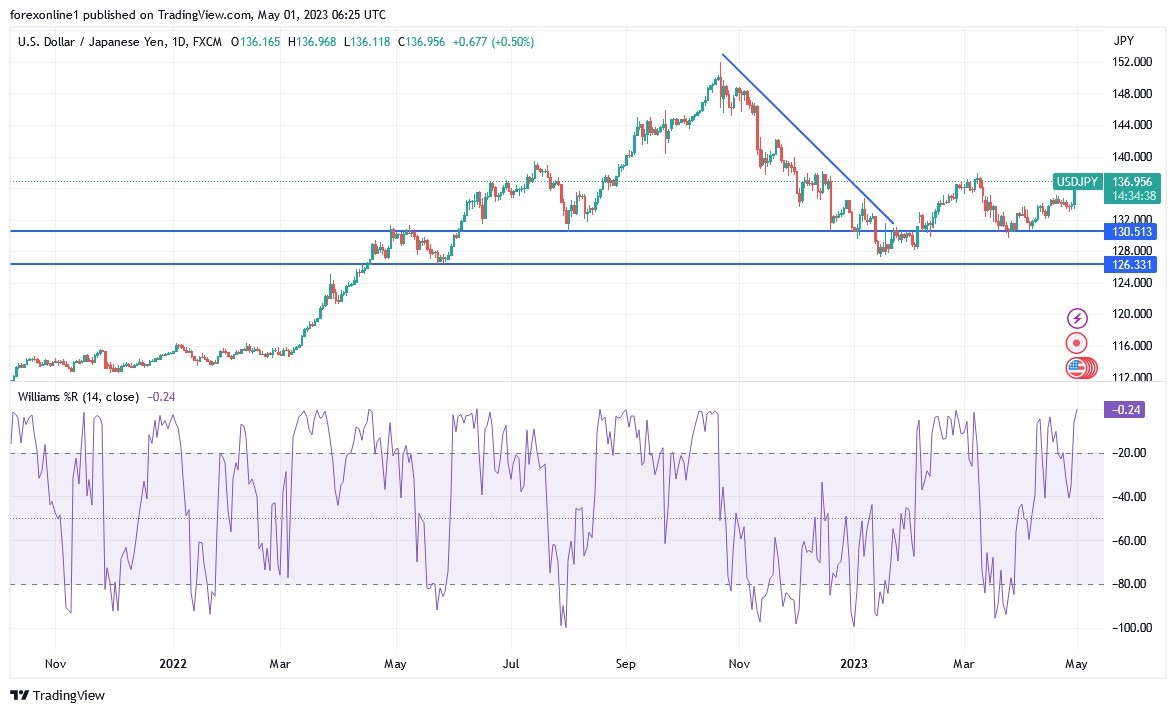After the Japanese central bank maintained its stimulus policy at the end of last week at the first meeting of the new Japanese central bank governor, the Japanese yen collapsed against the rest of the other major currencies. This was led by the USD/JPY currency pair, which jumped to the 136.56 resistance level at the end of the week, the highest for the currency pair for almost two months. The gains of the dollar / yen currency pair are on an important date this week, as the US Federal Reserve will announce an update of its monetary policy decisions. This is amid expectations of a quarter-point increase, but its policy statement and the bank’s governor’s statements will have the strongest impact on the US dollar pairs.
Official data indicated that the Federal Reserve (Fed) is approaching land in its battle against US inflation, which has raised uncertainty about the interest rate decision next Wednesday. The dollar was sold off heavily in North American trade as losses mounted after a University of Michigan survey showed that US consumer confidence about the economic outlook rose along with inflation expectations in April.
In addition, the Institute for Supply Management's (ISM) Chicago Business Index signaled a rebound in April for one of the largest city economies in the US, while the Bureau of Economic Analysis (BEA) noted that the Fed is closing the gap between it and its inflation target. The bureau said personal consumption expenditures (PCE) price index inflation — the Fed's target — fell from an upwardly revised 5.1% to 4.2% in March, remaining at its lowest level since May 2021, after a decline in the price of energy goods and services.
More importantly, core PCE inflation also declined after service price inflation was halved to a level that may already be consistent with the Fed achieving its 2% inflation target on an ongoing basis. To the extent FOMC members agree, this could lead to a decision to leave the Federal Reserve interest rate unchanged next Wednesday with downward repercussions on the US dollar exchange rates.
Service industry inflation has been the main focus of the Fed's interest rate over the past year, and once you overlook rising housing costs, it may be in the process of falling below target levels. Sometimes the Fed ignores housing inflation because of its susceptibility to short-term increases with interest rates themselves rising. And it's not just lower US inflation that may prompt the Fed to leave borrowing costs unchanged next Wednesday, because there has also been a renewed increase in market concerns surrounding the stability of small and medium-sized banks over the past week.
Emergency borrowing from the US Federal Reserve has picked up recently while this type of concern and development was reported in late March as a reason why a more cautious approach to raising borrowing costs, if they are raised at all, is likely in the near future.
Technical analysis of the USD/JPY pair:
In the near term, and according to the performance on the hourly chart,
- It appears that the USD/JPY currency pair is trading within a bullish channel formation.
- This indicates a significant short-term bullish bias in market sentiment.
- Therefore, the bulls will look to extend the current range of gains towards 136.580 or higher to the resistance 136.875.
- On the other hand, the bears will target short-term gains at around 135,952 or below at 135,620 support.
On the long run, and according to the performance on the daily chart, it appears that the USD/JPY is trading within the formation of an ascending channel. This indicates a significant long-term bullish bias in market sentiment. Therefore, the bulls will target long-term profits around 137.594 or higher at the resistance 139.784. On the other hand, the bears will look to pounce on the gains at around 134,554 or below at the support at 132,474.
Ready to trade our daily Forex analysis? We’ve made a list of the best Forex brokers worth trading with.



